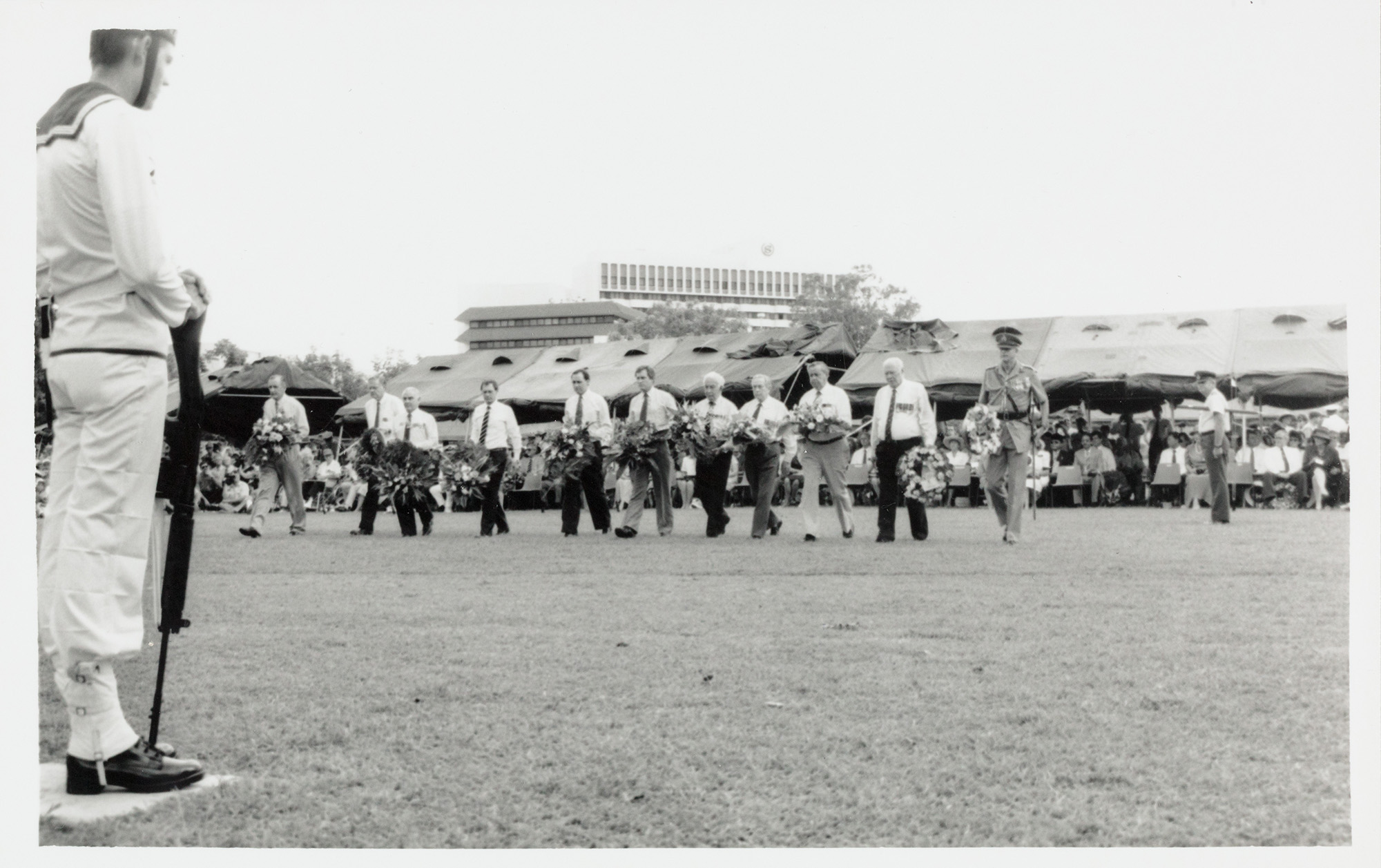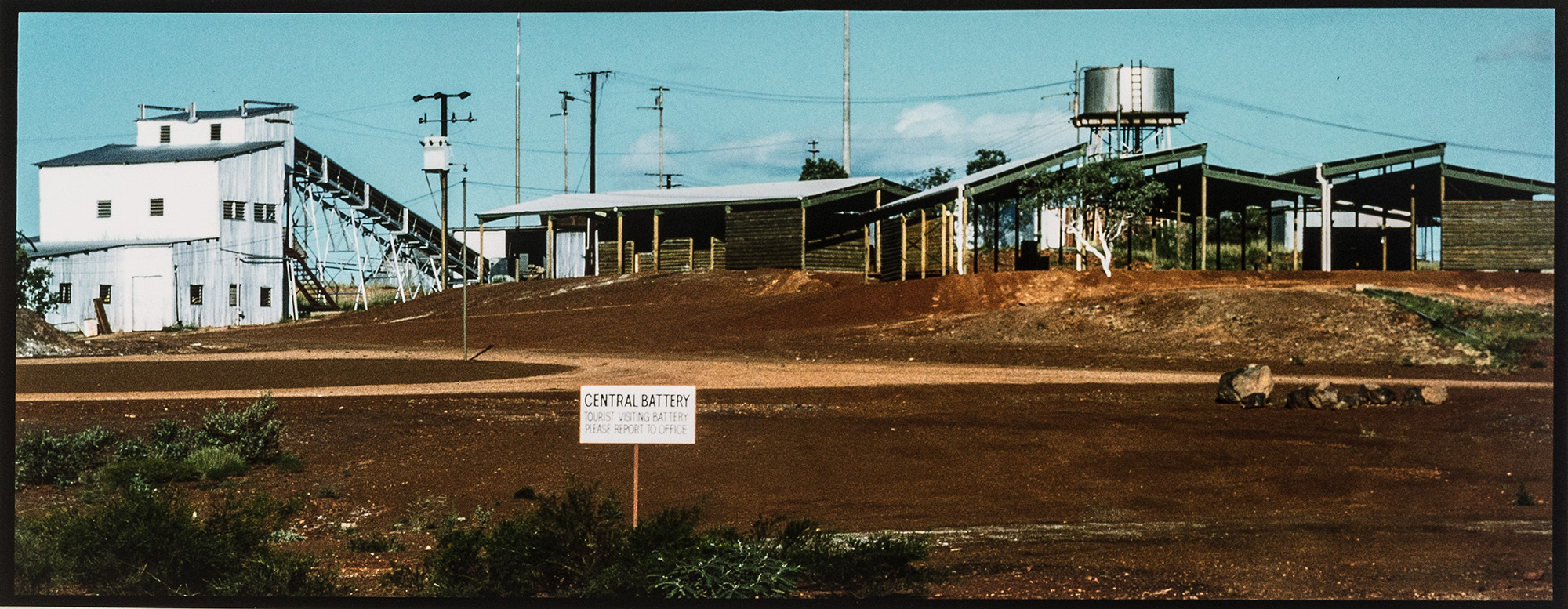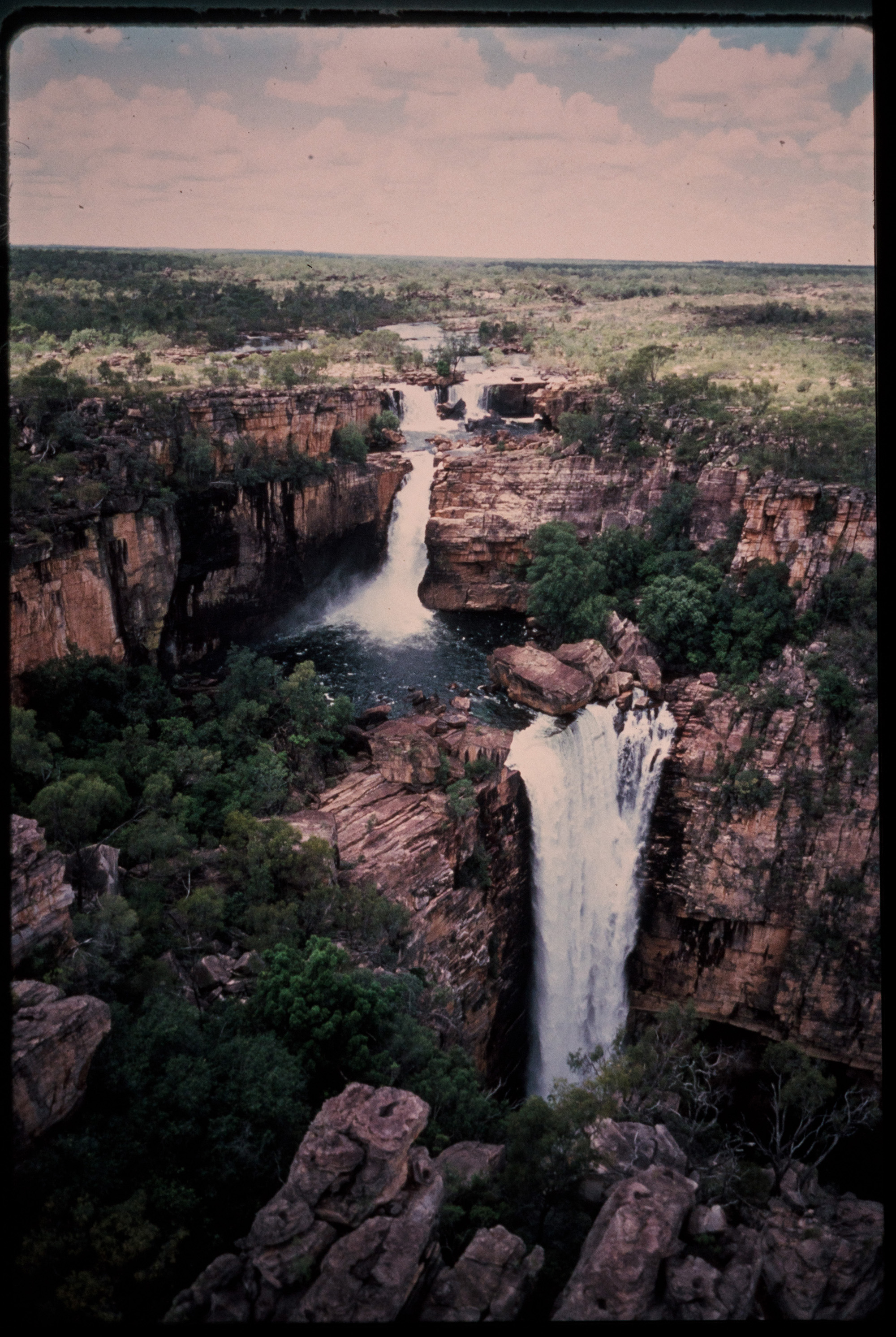Records 1992
About 1992
Highlight information about some key moments and events that happened locally in the NT, across Australia and internationally in 1992.
Local
The Northern Territory population at the end of 1992 was estimated to be 168,000 people.
19 February – Ceremonies commemorating 50 years since the first two air raids during WWII on Darwin are held.
4 March – NT News front cover features Mrs Karen Christopher, the first lawyer to complete their entire legal training in the Northern Territory was admitted to the Supreme Court.
7 March – NT News reported that the old underground oil storage tunnels network at Darwin Wharf is to become a commercial tourism venture.
8 March – Exercise Kangaroo ’92 involving 14,000 armed forces personnel from Australia and the USA, commences in the Northern Territory and East Kimberly region of WA.
13 March – NT News reports that the last of the pastoral stations owned by Vesteys in the Northern Territory have been sold, ending the Vestey Cattle empire’s long and controversial association with the Northern Territory.
15 April – Cyclone Neville, Category 4, causes extensive tree damage on Cobourg Peninsula and the Tiwi Islands.
May – The first stage of the military build–up in the Northern Territory (Armed Presence in the North, or APIN) begins with the relocation of the 2nd Cavalry Regiment to Darwin.
1 May – NT News front cover features Thiess Brothers bulldozers beginning works on the $120 million Cullen Bay Marina project.
21 May – In a ceremony conducted by Mr Speaker, a time capsule, to be opened in 2048 to mark a centenary of the first sittings of the Northern Territory Legislative Council, was placed in the foundations of Parliament House (in the historical foyer adjacent to the reception hall and library)
10 August – Ms Sally Gordon Thomas, formerly Chief Magistrate of the Northern Territory, is the first woman to be appointed a Judge of the Supreme Court of the Northern Territory.
The Conservation Commission Annual report indicated that “in keeping with the spirit of this year’s World War II commemorative program the Commission launched the Military Heritage Trails. In addition the Archives Unit conducted 30 oral history interviews with veterans and civilians who returned to Darwin for the events”.
The Environmental Impact Statement for the construction of the Bayview Haven Canal Estate was complete in June 1992, making way for construction to begin.
The Conservation Commission reported that the Territory’s waste management efforts took a major step forward [in 1992] when the new Shoal Bay Regional Recycling Centre was opened in conjunction with the Darwin City Council.
The Legislative Assembly Annual Report included that arrangements were underway for the amalgamation of the Parliamentary Library with the State Reference Library, in the new Parliament House, having consequence within the extended interior design stage for the new building.
“The new library will be housed on four levels of the building with two levels accessible to the public. Parking, hours of operation and public access will exceed provisions in the existing State Library and the facility is expected to be a showpiece”.
National
2 January – President of the United States of America, George HW Bush, addresses the Australian Parliament.
9 February – Major flooding on the east coast of Australia sees the Sydney harbour tunnel flooded with 500,000 litres of water. On 20 February residents evacuate their homes in towns north of Brisbane when hit by flash flooding. On 21 February a State of Emergency is declared in Maryborough and Gympie Queensland, and the whole of the Noosa Shire NSW on 22 February, due to major flooding.
24 February – Queen Elizabeth II visits Australia.
25 May – Lindy Chamberlain receives compensation for wrongful conviction on murder charges.
3 June – The High Court of Australia decides the case of Mabo V Queensland (No. 2) a landmark decision recognising native title in Australia. The decision overturns the concept of terra nullius, the notion of Australia as an unoccupied land at the time of British settlement.
24 June – NSW Premier Nick Greiner resigns following a corruption scandal and is replaced by John Fahey.
30 August – The Australian Greens Party is formed by representatives from the Tasmanian, Queensland and NSW Greens Party, with observers from other states.
19 September – state election in Queensland returns Wayne Goss and the Labor Government to power for a second term following the end of the 32 year Bjelke-Pederson era in 1989.
23 November – Prime Minister Paul Keating announces the end of a ban preventing homosexual men and women from serving in the Australian Defence Force.
3 October – a state election in Victoria see’s Jeff Kennett’s Liberal Party take government from former premier Joan Kirner.
10 December – Australian Prime Minister Paul Keating at Australian launch of the International Year for the world’s Indigenous people 1993, delivers what will become known as the 'Redfern Speech'. Keating was the first Australian prime minister to publicly acknowledge to Indigenous Australians that European settlers were responsible for the difficulties Australian Aboriginal communities continued to face.
14 December – Kakadu National Park, encompassing stage 3 which includes Coronation Hill, is listed as a World Heritage Area.
International
21 January – a Memorandum of Understanding between the Northern Territory and Indonesia is signed in Jakarta.
15 January – the Socialist Federal Republic of Yugoslavia begins to break up, and is fully disintegrated by 27 April, resulting in several successor states of Bosnia and Herzegovina, Croatia, Macedonia, Slovenia and later Serbia and Montenegro.
26 January – Russian President Boris Yeltsin announces that Russia will stop targeting cities of the United States and United States allies with nuclear weapons. In return United States President George HW Bush announces that United States and allies will stop targeting Russia and the remaining communist states with nuclear weapons.
30 January – North Korea signs an accord with the International Atomic Energy Agency allowing for international inspections of North Korea’s nuclear power plants.
1 February – United States president George HW Bush and Russian President Boris Yeltsin meet at Camp David in Maryland United States, where they formally declare that the Cold War is over.
14 February – Ukraine and four other nations in the Commonwealth of Independent States reject Russia’s proposal to maintain unified armed forces. Ukraine, Moldova, and Azerbaijan announce they will go ahead with plans to create their own military forces.
9 March – The People’s Republic of China ratifies the Nuclear Non-Proliferation Treaty.
22 March – Space Shuttle Atlantis takes off from Cape Canaveral carrying instruments designed to study global warming.
5 April – Serb troops, following a mass rebellion of Serbs in Bosnia and Herzegovina against the Bosnian declaration of independence from Yugoslavia, besiege the city of Sarajevo.
2 May – NT News reports that “thousands of troops and police stood by, surrendering neighbourhoods [of Los Angeles] to looters, brick throwers and rioters, with 24 people killed, and at least 900 injured, following the acquittal of four white policemen in the videotaped beating of black motorist Rodney King”.
7 May – Space Shuttle Endeavour makes its maiden flight, as a replacement for Space Shuttle Challenger which was destroyed after take-off on its tenth flight in 1986.
3-14 June – The Earth Summit is held in Rio De Janeiro, Brazil. The first World Oceans Day is celebrated on 8 June coinciding with the Summit.
3-4 August – Millions of black South Africans participate in a general strike called by the African National Congress to protest the lack of progress in negotiations with the government of the State President of the Republic of South Africa.
Popular culture, arts, sport and entertainment
26 January – The first Big Day Out music festival is held at the Sydney Showgrounds, with headline acts Violent Femmes, and Nirvana.
14 March – Foreign Correspondent premieres on the ABC.
30 March – The Silence of the Lambs, released in 1991, wins five Academy Awards, becoming only the third movie to win the ‘big 5’; Best Film, Director, Actor, Actress and Screenplay.
20 April – The Freddie Mercury Tribute Concert, held at Wembley Stadium London, is televised to over one billion people raising millions of dollars for AIDS research.
3 June – Chief Minister Marshall Peron officially opens NT Museum of Arts and Sciences Maritime Gallery which features more than 30 examples of marine craft and boating designs.
20 July – Bananas in Pyjamas premiers on the ABC.
21 July – Sylvania Waters premieres on Australian television. Sylvania Waters was an Australian reality television series that followed the lives of an Australian family – one of the first such programs in Australia.
7 August – Unforgiven, starring and directed by Clint Eastwood, is released. The film won four Academy Awards, including Best Picture and Best Director for Clint Eastwood the following year.
20 August – Australian movie Strictly Ballroom, directed by Baz Luhrmann, is released.
26 September – West Coast Eagles (16.17.113) defeat Geelong (12.13.85) in the first non-Melbourne-only Grand Final, to win the 96th AFL premiership. It is the first time that the VFL/AFL premiership has left Victoria.
27 September – Brisbane Broncos (28) defeat St. George Dragons (8) to win the 85th NSWRL premiership. It is the first time that the NSWRL premiership has gone to Queensland.
3 November – Written and originally recorded by Dolly Parton in 1973, ‘I Will Always Love You’ is released by Whitney Houston. ‘The Bodyguard’ original soundtrack album featuring this song, went on to sell over 45 million copies worldwide becoming the biggest selling soundtrack of all time.
12 November – Romper Stomper, starring Russell Crowe is released.
1992 sees the passing of well-known Australian artist Brett Whitley (b.1939), musician Peter Allen (b. 1944), photographer Max Dupain (b. 1911), and artist Sidney Nolan (b. 1917).
In Australia the top five popular music singles listed by the Australian Recording Industry Association included ‘Achy Breaky Heart’ by Billy Ray Cyrus, ‘November Rain’ by Guns N’ Roses, ‘End of the Road’ by Boyz II Men, ‘To Be With You’ by Mr Big, and ‘Amigos Para Siempre’ (Friends for Life) by José Carreras & Sarah Brightman. Australian artists featured in the top 100 with ‘The Day You Went Away’ by Wendy Matthews at number eight, ‘Ordinary Angels’ by Frente! at number 20, and ‘Way Out West’ by James Blundell and James Reyne at number 22 on the charts.
Australian comedy shows Fast Forward and Acropolis Now finished broadcasting on Channel 7 in 1992.
This was the era of Buffy the Vampire Slayer, and Waynes World, which influenced fashion trends.
One of the most popular early ‘90s looks was grunge. It entered mainstream fashion in 1992, when grunge bands like Nirvana, Pearl Jam, and Soundgarden rose to popularity. This look included darker coloured plaid flannel shirts, stonewashed or ripped jeans, Doc Martens, combat boots, Birkenstocks, and high top sneakers.
Rump steak was selling for $4.45 per kilo, a tin of soup for $1.25 and a kilo of apples for $1.40 per kilo. A carton of 24 light beer $18.95, of 24 full strength beer for $24.95 and a bottle of scotch whisky for $21.50.
Return fares for flights Darwin to Alice Springs with Ansett cost $339, and from Darwin to Adelaide for $509 return.
Territory Mutual credit society was offering home loans at the variable interest rate of 11%. A three bedroom ‘Vintage Centralian’ home in Eastside selling for $112,000. The same price was being asked for a standard elevated three bedroom home in Woodroffe, while a five bedroom ‘old Darwin charm’ home in Ludmilla was seeing for $190,000. A beach block at Dundee was selling for $80,000.
References
Transcript 8394 | PM Transcripts (pmc.gov.au) [https://pmtranscripts.pmc.gov.au/release/transcript-8394]
SPEECH BY THE HON PRIME MINISTER, P J KEATING MP AUSTRALIAN LAUNCH OF THE INTERNATIONAL YEAR FOR THE WORLD’S INDIGENOUS PEOPLE REDFERN, 10 DECEMBER 1992 (pmc.gov.au)
https://en.wikipedia.org/wiki/1992_in_Australia
NT News, Saturday 7 March 1992, Page 1
NT News, Wednesday 4 March 1992, Page 1
NT News, Friday 13 March 1992, Page 1
NT News, Friday 1 May 1992, Page 1
NT news, Saturday 2 May 1992, Page 2
NT Chronicle, 1992, prepared by Steve Bennett, edited by His Honour Neil Conn, AO Administrator of the Northern Territory, https://shanestone.s3.amazonaws.com/uploads/ document/file/1128/NT_Chronicle_1992.pdf
https://en.wikipedia.org/wiki/Serbia_and_Montenegro
https://en.wikipedia.org/wiki/Socialist_Federal_Republic_of_Yugoslavia
https://en.wikipedia.org/wiki/Redfern_Park_Speech#cite_note-syddict-2
1992 - Wikipedia
https://ntepa.nt.gov.au/__data/assets/pdf_file/0003/286428/BayviewHaven.pdf
https://ntepa.nt.gov.au/__data/assets/pdf_file/0010/286426/noi_bayview_boulevarde.pdf
https://territorystories.nt.gov.au/10070/398404 Annual Report 1991-1992 Conservation Commission Tabled Paper 1290
“Annual Report 1991-1992 Department of the Legislative Assembly”. 17 November 1992 https://territorystories.nt.gov.au/10070/398398/0/80.
Print all pages in this section
Give feedback about this page.
Share this page:
URL copied!




![Colour slide aerial view of Darwin [showing Cullen Bay]<br> Image courtesy of Library & Archives NT, Frank Woerle Collection, NTRS 3876](https://tfhc.nt.gov.au/__data/assets/image/0004/1175611/08-colour-aerial-view-darwin-cullen.jpg)





